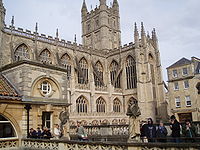Bathwick
The district became part of the Bath urban area with the 18th century development of the Pulteney estate and the building of Pulteney Bridge. Subsequently, various Georgian streets were built including Sydney Place, Great Pulteney Street and Laura Place, with Bathwick Hill leading up to Claverton Down and the University of Bath.
It is also home to the Holburne Museum of Art within Sydney Gardens, Bath Recreation Ground (The Home of Premiership, Bath Rugby) and The North Parade Ground, the current home to Bath Cricket Club and Bath City's first ever ground from 1889 to 1891.
Bathwick has two churches: St John the Baptist, Bathwick and St Mary the Virgin, Bathwick. The latter was built in the early 19th century by John Pinch the Elder, and was where the band Muse recorded the organ sections on their second studio album Origin of Symmetry.
Governance
Bathwick was part of the hundred of Bath Forum. In 1891 the civil parish had a population of 4714. On 26 March 1900 the parish was abolished to form Bath.
See also
References
- ^ "Ward population 2011". Retrieved 7 April 2015.
- ^ "Your guide to the Rec". Bath Rugby. Retrieved 20 March 2023.
- ^ "Football". British Newspaper Archive. Bath Chronicle. 10 October 1889. p. 2. Retrieved 3 November 2022.
- ^ "Church of St Mary". Images of England. English Heritage. Archived from the original on 7 October 2012. Retrieved 7 February 2009.
- ^ "Muse — Origin of Symmetry". Discogs. Retrieved 1 July 2008.
- ^ Reverend John Collinson (1791). The History and Antiquities of the County of Somerset. Vol. 1. p. 97. ISBN 978-1-171-40217-6.
- ^ "Somerset Hundreds". GENUKI. Retrieved 9 September 2011.
- ^ "Population statistics Bathwick AP/CP through time". A Vision of Britain through Time. Retrieved 30 March 2024.
- ^ "Relationships and changes Bathwick AP/CP through time". A Vision of Britain through Time. Retrieved 30 March 2024.
External links
